Union Public Service Commission(UPSC) conducts Civil Services Examination which is a nationwide competitive exam conducted every year.
The exam is conducted in three different stages and the Preliminary exam is the first stage. Lakhs of candidates appear for the exam each year and a total of over 10.58 lakh candidates have applied for the UPSC Prelims examination from pan India in 2020.
The exam is conducted in three successive stages-namely:
- Preliminary: A screening test for selection for Mains exam ( conducted in June)
- Mains Examination: for selection of various services and posts(conducted in October)
- Personality Test: conducted during February – April
Each round will be an elimination round to filter out candidates for successive levels. UPSC results will be announced on its official website upsc.gov.in and candidates can download UPSC previous year question
| Marks | Number of Questions | Duration | |
| Paper I | 200 | 100 | 2 hours |
| Paper II | 200 | 80 | 2 hours |
The preliminary exam comprises two compulsory papers namely General Studies Paper I and General Studies Paper-II, popularly known as CSAT.
How Prelims Marks Are Calculated?
Both the papers consist of objective multiple-choice questions. GS Paper I consists of 100 questions and each question carries 2 marks and GS paper II consists of 80 questions and each question here carries 2.5 marks.
However, there is negative marking for every incorrect option marked by the candidate, and 1/3rd of the mark allotted to the question will be deducted as a penalty. Thus for every wrong answer in paper I, 0.66 marks will be deducted and on paper II 0.83 marks will be deducted as a penalty.
The Examination is conducted for 2 hours for each paper and both papers to be written on the same day. GS Paper II is just a qualifying paper wherein the candidate needs to score a minimum of 33% to clear the paper, i.e., if a candidate secures a score above 66, it can be assured that he/she has cleared paper II.
Thus only the marks scored in Paper I shall be counted to be eligible to write the mains examination. Considering the unpredictable nature of the UPSC civil service exam, candidates should not overlook the CSAT paper and prepare for it well in advance.
UPSC cut-off is the minimum qualifying marks obtained by the last recommended candidate across different categories for that particular stage, be it Mains list, Interview list, or Final rank list. The cut-off mark varies every year and it ranges between 96-110 for a general category candidate.
UPSC has become unpredictable by playing with a variety of questions asked and areas covered in the question paper.
GS paper 1 and 2 is a combination of the dynamic and static syllabus. In this scenario innovation in the ways of preparation has become imperative and analyzing the previous year’s question papers and the weightage assigned to each section of the syllabus is important.
The Syllabus For UPSC Preliminary Exam Is As Follows:
General Studies Paper – I (200 marks, 2 hours)
- Current events of national and international importance.
- History of India and Indian National Movement.
- Indian and World Geography-Physical, Social, Economic Geography of India and the World.
- Indian Polity and Governance – Constitution, Political System, Panchayati Raj, Public Policy, Rights Issues, etc.
- Economic and Social Development – Sustainable Development, Poverty, Inclusion, Demographics, Social Sector initiatives, etc.
- General issues on Environmental Ecology, Biodiversity and Climate Change – that do not require subject specialization
- General Science
CSAT/ General Studies Paper-II (200 marks, 2 hours)
- Comprehension
- Interpersonal skills including communication skills
- Logical reasoning and analytical ability
- Decision-making and problem solving
- General mental ability
- Basic numeracy (numbers and their relations, orders of magnitude, etc.) – Class X level)
Major Subjects in General Studies Paper-I are:
- History
- Environment
- Polity
- Economy
- Geography
- Art and Culture
- Science and Technology
- International Relations and Agriculture
There is no fixed weightage for each subject in paper 1 of UPSC prelims. The best we can do is to identify a trend in the weightage of each subject by analyzing previous year papers. The following table shows the weightage of each section and sub-section of GS paper-I and GS Paper-II in the preliminary exam.
| UPSC previous Year Question paper Analysis-Subject wise | |||
| Subject | Sub-sections | No. of Questions | Total |
| Economy | Basic Economy | 4 | 24 |
| Fundamental(core Economy) | 3 | ||
| Current affairs related | 17 | ||
| Environmnet | Organizations | 4 | 14 |
| Biodiversity | 6 | ||
| Climate change/Pollution | 4 | ||
| Geography | Human/Economical Geography | 1 | 8 |
| Physical Geography | 3 | ||
| Map | 4 | ||
| History | Ancient/Medieval | 2 | 13 |
| Art and Culture | 5 | ||
| Modern Indian History | 6 | ||
| International Relations | International Organizations | 4 | 9 |
| Bilateral and multilateral relations | 5 | ||
| Polity | Bills and Acts | 1 | 24 |
| Government, Parliament and other Bodies | 7 | ||
| Basic functions of Constitution | 16 | ||
| Science and Tech | Current Affairs related | 6 | 8 |
| Basics | 2 |
| IAS Prelims CSAT GS Paper-II 2019 Exam Analysis | IAS Prelims CSAT GS Paper-II 2020 Exam Analysis | |
| Important Topics | Number of Questions | Number of Questions |
| Quantitative Aptitude | 32 | 39 |
| Logical Reasoning | 18 | 14 |
| English Comprehension | 30 | 25 |
| Data Interpretation | 00 | 02 |
| Total | 80 | 80 |
The pie-chart picturizes the percentage of marks assigned to each section of both GS paper-I and CSAT paper.
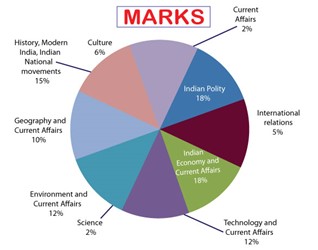
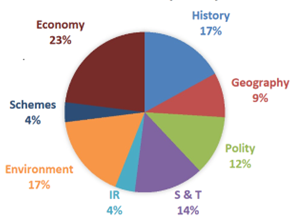
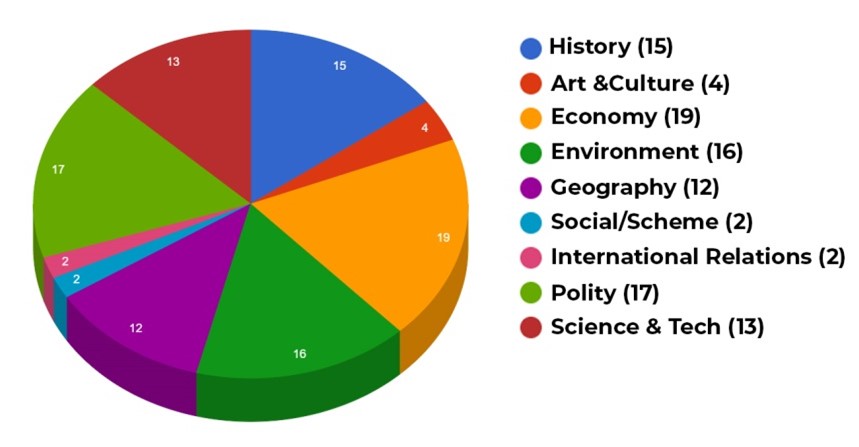
The year 2018: Questions from current affairs were an amalgamation of direct and indirect. On the other hand, questions related to Indian Polity are so framed, that even the best students get confused as well as some of the questions were blended with Current Affairs, Law, and Indian Economy.
There were 16 questions from the economy, among which 13 were difficult. Indian Banking System acquired prominence this year and 4 questions were asked from this area.
The year 2019: Out of 100 questions, 15 were from Indian polity and governance. Most of the history-related questions were from the modern part: 5 questions from modern history, 4 questions were an amalgamation of history with art and culture, 3 questions were from ancient history, and 1 from the post-independence period. There were around 23 questions from the Indian Economy.
The year 2020: GS Paper-1 was moderately tough with major sections from Agriculture, Economy, and Banking.
There were more questions based on Economy and Environment and lesser on History, Polity, and Current Affairs. The economy had a total of 14 questions, and there had been 18 questions in History, from Ancient, Medieval, and Culture with a blend of easy, moderate, and tough levels of questions. The geography section had 10 questions. The environment section had 17 questions.
If we analyze the latest trend Polity and Economy have been carrying more marks. Around 17 to 18 questions come from Polity and 18 to 23 questions come from Economy. The environment had shown a somewhat stable trend hovering around 15 to 18 questions most of the years. The other subjects show wide variations every year. The history section frequently includes questions from Art and Culture as well and aspirants are advised not to ignore these topics.
Current Affairs is the most important section. It covers almost 50% of the prelims question directly or indirectly and this again varies each year. For this section, candidates should make a habit of reading newspapers and magazines (online/offline) to gain potential.
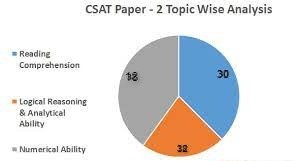
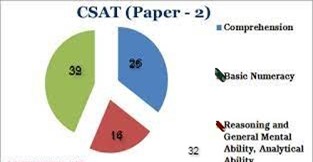
Fig: analysis of CSAT paper 2019 Fig: analysis of CSAT paper 2020
In the CSAT paper (GS Paper-II)in the year 2019, the level of the questions was from moderate to difficult. The Highest weightage was given to Quantitative aptitude which included 32 questions followed by 30 questions from English comprehension.
In the year 2020 CSAT paper, the overall questions were tough. The questions were asked mainly from three major topics namely 39 questions on Mathematics and Basic Numeracy, 25 questions on Reading Comprehension, and 10 from Logical and Analytical Reasoning.
Data interpretation which came in a big way in 2018 was completely missing in 2019 and only one question in 2020. Data sufficiency suddenly arrived with 5 questions in 2020.
Nevertheless, aspirants should practice previous year’s UPSC papers to check their preparedness. One of the best ways to prepare for General Studies paper-I and CSAT is through previous years’ question papers.
Once thorough with the paper pattern, aspirants should prepare each section. Another important aspect is identifying your strengths and weaknesses related to a subject. While solving mock papers, identify which type of questions you are repeatedly attempting wrong and correctly, analyze your performance in the mock papers.
UPSC is known for its unpredictable nature of setting question papers so it’s always safe to give importance to all subjects and worry less about the marks allotted for each subject. However, analysis helps in a way to ensure that an aspirant does not leave any of the syllabus uncovered which has a high probability of appearing in the exam.
Wish you good luck with the upcoming Preliminary Exam!





